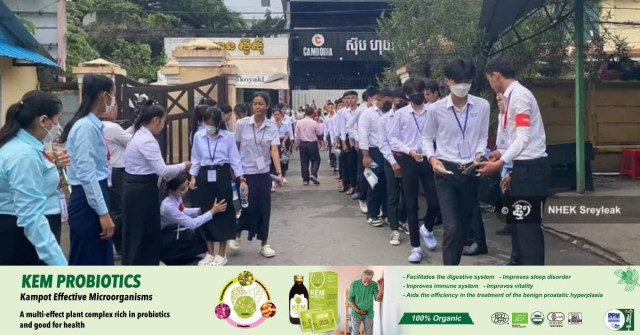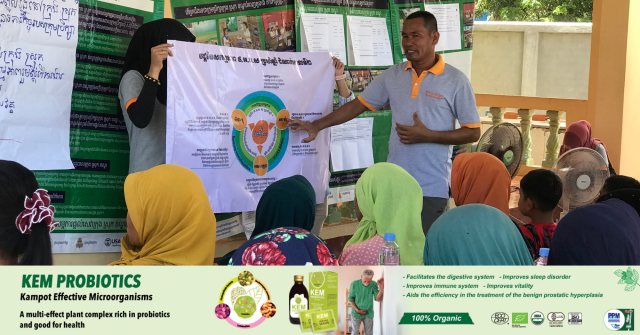Khmer Houl Fabric under Threat from Imported Cheap Textile
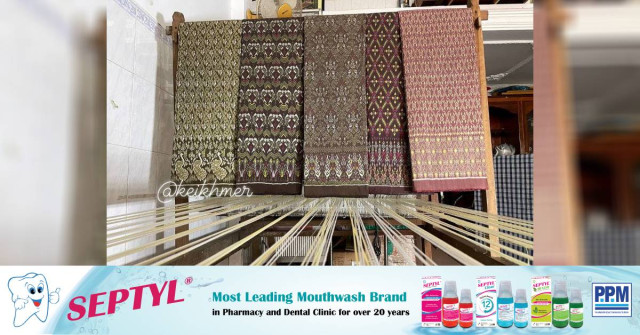
- By Po Sakun
- December 15, 2023 10:00 AM
PHNOM PENH — Cambodia’s traditional “Khmer houl”—a multicolored handwoven silk fabric with complicated designs—is being threatened by the imported, easily-made and relatively cheap fabric to the extent that, a weaver warns, this tradition is disappearing as less people weave and the time-consuming techniques required to produce this fabric make it hard to capture the already-narrowed market.
Pheng Sophal established the Kei Khmer Community in 2017 after working for an organization involved in weaving for about 20 years, he said during an interview. His goal: to preserve the traditional Khmer houl weaving skills.
The community includes members in Takeo province’s Samrong and Prey Kabas district and in Kampong Cham province. They work on Khmer houl weaving, krama weaving, and natural dye according to Khmer traditional Khmer techniques.
“We try to restore the tradition to show the younger generation as well as the general public the Khmer weaving culture,” Sophal said.
The Kei Khmer community consists of 15 weavers with many years of experience who maintain the high quality of traditional weaving, he said. They are mainly middle-aged and elderly people. Most of them have household duties and don't have other option than working at home, near their families. So, they weave even though they earn less than if they worked away from home, Sophal said.
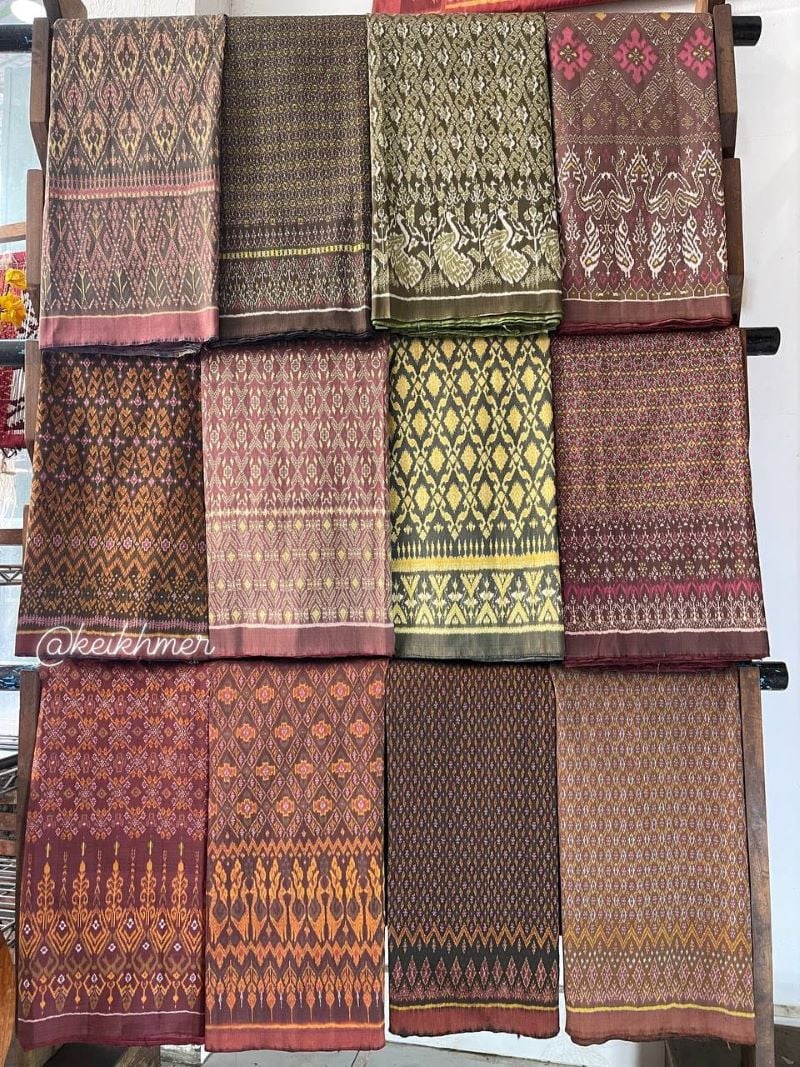 Handweaving Khmer houl is not an easy task. Photo: Kei Khmer Community
Handweaving Khmer houl is not an easy task. Photo: Kei Khmer Community
Working hard to preserve the tradition
Handweaving Khmer houl is not an easy task as it requires, not only technique and skills, but also physical and mental efforts during this time-consuming work, he explained. And yet, there are people who really love and want to maintain this traditional Khmer product, which motivates them to continue weaving, he said.
“The younger generation does not want to weave because they are less patient, and this job pays little,” Sophal said. “Most of them go to work in factories because they earn more and are not as tired as when weaving.”
According to Sophal, houl weaving is less complicated than pattern weaving. There are many steps in the making of a pattern depending on the style or image for the skirt. The weaver needs to count the tiny threads of silk one by one to create the pattern. The counting is required to determine the skirt’s size, pattern and style.
If the houl is small, a lump of pattern can have between 40 and 50 threads. But if the houl is big, one piece can mean tying between 80 to 100 threads or more.
“First, they bind the pattern to make a picture,” Sophal said. “Then, they have to know the colors required. They need to know where the yellow color is and the red is. So, we have to tie it. Tiying a pattern takes longer than weaving because there are many artistic designs.
“If we tie only one color, it’s fine, but if we tie one or three colors, we have to tie them several times, so it takes a long time,” he said.
While weaving is painstaking work, creating dye is another important part that also requires skills. Natural dyes are made from various barks, coconut shells, ebony tree (diospyros mollis), indigo leaves, bamboo leaves, turmeric and jackfruit wood. These natural products produce muted colors as opposed to the chemical or imported dyes that produce bright colors.
Ebony contains a substance that makes black color, and turmeric and jackfruit wood yellow while indigo leaves make a perfect blue. “Because the [tree] bark is hard, we have to chop it thoroughly and boil, then filter it,” Sophal said. “After that, we can soak the silk. It takes about an hour to two hours to do so.
“Soaking is quite a demanding task too,” he said. “At this stage, if the person is unskilled or negligent, the hard work from the very beginning will be in vain. It is because if the color is uneven or stained by anything, the price will have to decrease or the skirt cannot be sold at all.
“If the color is not the same, the fabric will contain different levels of color: Some part maybe brighter and some darker,” Sophal said. “How can it be beautiful if the color does not match everywhere.”
Dyeing the thread is very difficult because it depends on the strength of the hand washing the silk thread so that the color penetrates every part of it, he said. If the thread is not soaked thoroughly enough, the color will not reach the inner part, which will be used to tie the pattern. So, the person who is dying must have a lot of experience, combined with strength and washing techniques, Sophal said.
This work requires attention to detail and takes a long time, he said. If doing it alone, it takes more than a month to have a complete roll of silk skirt, he said. With many people helping, it can be done in a month.
 Creating dye is another important part that also requires skills. Photo: Kei Khmer Community
Creating dye is another important part that also requires skills. Photo: Kei Khmer Community
Imported fabric versus locally-made Khmer houl
“Why is it so expensive? If we think about the process of the work, it is not expensive because it takes a very long time to make,” Sophal said. “Seeing only the results, we don’t know how hard it is. When we see the process, we realize how miserable this work is. If we don’t, we just ask why it is expensive.
“After covering the costs, we can get about $100 and sometimes less if the weaving is not very good,” he said. “[T]hen they go to work in a factory instead.”
Although Khmer houl is produced through blood, sweat and tears, it cannot compete with the imported products, Sophal said. Many buyers complain that Khmer houl is expensive and the colors not as beautiful as on imported products, he said.
According to Sophal, most Cambodians now buy houl made in Thailand or with imported dyes. As for the traditional Khmer houl, there are very few buyers, he said.
“Our Cambodian dyes are of good quality and do not affect health,” Sophal said. “There are two types of imported dyes [sold on the market]. The type with a ghost head on the label has an impact on health and the environment. The other type does not affect health but is more expensive than the dyes with the ghost-head label.”
Unfortunately, Cambodians keep using imported goods more than domestic products, he said.
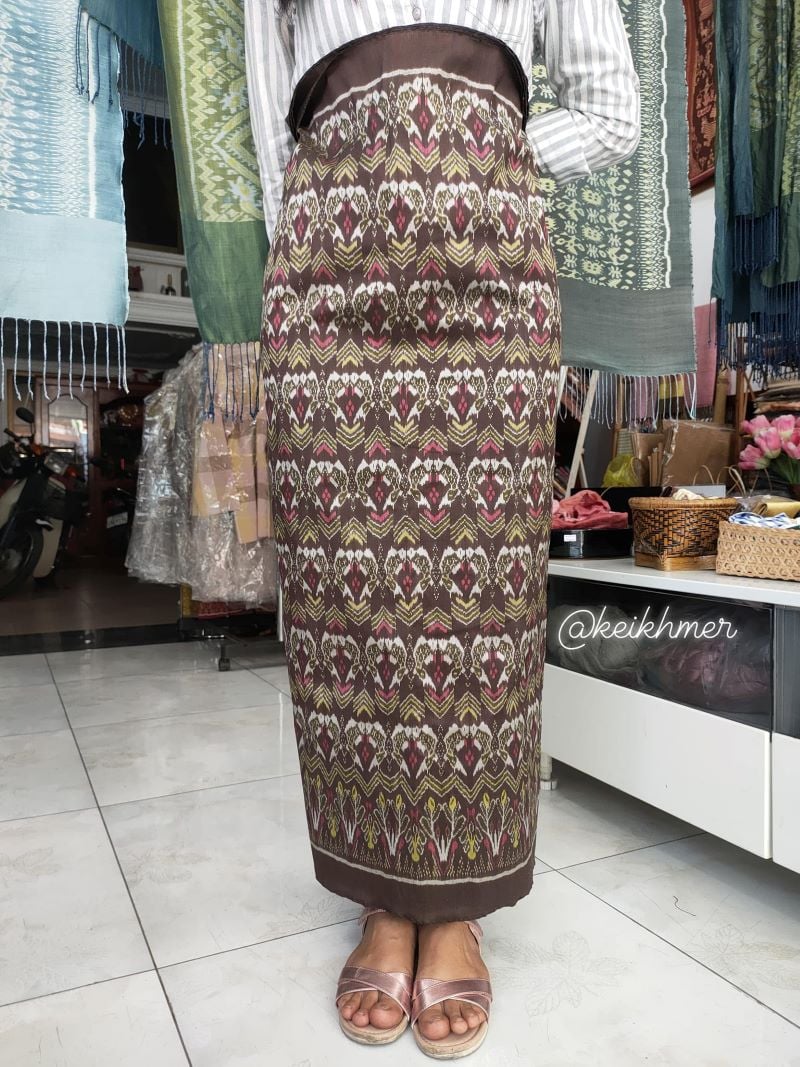 Khmer houl is bought mainly by tailors or to make wedding dresses. Photo: Kei Khmer Community
Khmer houl is bought mainly by tailors or to make wedding dresses. Photo: Kei Khmer Community
Turning the tide
Khmer houl is bought mainly by tailors or to make wedding dresses, Sophal said. However, the market is still small due to the strong competition from imported houl and printed fabrics, which are non-woven and very affordable.
“Printed houl is not weaving,” he said. “A roll of printed one costs $30 to $50. Our houl ranges from $200 to $300. Cambodians then have this idea that they are the same, and that no one will know whether it is a Cambodian product or imported one when it is a dress.”
This lack of interest discourages houl weavers, Sophal said. “Then the weavers think that if their products cannot be sold at a proper price, why continue to work since [one cannot earn] enough support the family? So why not find another job.
“So our cultural values are gradually fading away, because we do not value what belongs to Cambodia,” he said.
Despite the low market demand for his community product, Sophal said that he continues to help weavers to have this source of income to support their families and not end up unemployed.
Sophal urges all Cambodians to support Cambodian products made by Cambodians in the traditional way. And this, both for today’s weavers who need to make a living and to make sure that the next generation know its value.
Otherwise, the tradition will gradually disappear, and one day will be gone in the country, Sophal said. “When it’s gone or being done by foreigners, please don’t regret it or say it is ours and quarrel with them, because when it was still here, we did not care,” he said.
Originally written in Khmer for ThmeyThmey, this article was translated by Torn Chanritheara for Cambodianess.








